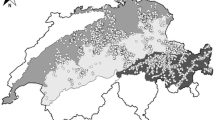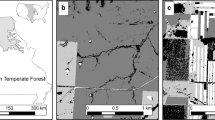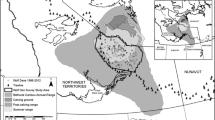Abstract
We examined the relationship between survival of roe deer (Capreolus capreolus) fawns at Trois Fontaines, Champagne-Ardennes, France, and factors related to bed-site selection (predator avoidance and thermoregulation) and maternal food resources (forage availability in the maternal home range). Previous studies have demonstrated that at small scales, the young of large herbivores select bed sites independently from their mothers, although this selection takes place within the limits of their mother’s home range. Fawn survival was influenced largely by the availability of good bed sites within the maternal home range, not by the fawn’s selection of bed sites; however, selection for thermal cover when selecting bed sites positively influenced survival of young fawns. Typical features of a good home range included close proximity to habitat edges, which is related to forage accessibility for roe deer. The availability of bed sites changed as fawns aged, probably due to an increased mobility of the fawn or a different use of the home range by the mother; sites offering high concealment and thermal protection became less available in favor of areas with higher forage accessibility. Despite the minor influence of bed-site selection on survival, roe deer fawns strongly selected their bed sites according to several environmental factors linked to predator avoidance and thermoregulation. Fawns selected for sites providing concealment, light penetration, and avoided signs of wild boar (Sus scrofa) activity. Avoidance of sites with high light penetration by young fawns positively affected their survival, confirming a negative effect on thermoregulation due to reduced thermal cover. Selection for light penetration by older fawns was less clear. We discuss these results in the context of cross-generational effects in habitat selection across multiple scales, and the potential influence of the ‘ghost of predation past’.



Similar content being viewed by others
References
Alldredge AW, Deblinger RD, Peterson J (1991) Birth and fawn bed site selection by pronghorns in a sagebrush-steppe community. J Wildl Manage 55:222–227
Andersen R, Linnell JDC (1998) Ecological correlates of mortality of roe deer fawns in a predator-free environment. Can J Zool 76:1217–1225
Andersen R, Gaillard JM, Linnell JDC, Duncan P (2000) Factors affecting maternal care in an income breeder, the European roe deer. J Anim Ecol 69:672–682
Bertram MR, Vivion MT (2002) Moose mortality in eastern interior Alaska. J Wildl Manage 66:747–756
Bubenik AB (1965) Beitrag zur Geburtskunde und den Mutter-Kind Beziehungen des Reh- und Rotwildes. Z Säugetierkd 30:65–228
Burnham KP, Anderson DR (2002) Model selection and inference, 2nd edn. Springer, New York
Byers JA (1997) American pronghorn: social adaptations and the ghost of predators past. Chicago University Press, Chicago
Canon SK, Bryant FC (1997) Bed-site characteristics of pronghorn fawns. J Wildl Manage 61:1134–1141
Caro T (2005) Antipredator defenses in birds and mammals. Chicago University Press, Chicago
Cook JG, Irwin LL, Bryant LD, Riggs RA, Thomas JW (2005) Thermal cover needs of large ungulates: a review of hypothesis tests. In: Wisdom MJ (ed) The Starkey project: a synthesis of long-term studies of elk and mule deer. Reprinted from the 2004 transactions of the North American Wildlife and Natural Resources Conference. Alliance Communications Group, Lawrence, pp 185–196
Coulson T, Gaillard JM, Festa-Bianchet M (2005) Decomposing the variation in ungulate population growth into contributions from multiple vital rates. J Anim Ecol 74:789–801
Delorme D, Léger F (1990) A propos de l’attaque d’un faon de chevreuil (Capreolus capreolus) par un chat forestier (Felis sylvestris). Gibier Faune Sauvage 7:403–407
Eberhardt LL (2002) A paradigm for population analysis of long-lived vertebrates. Ecology 83:281–2854
Epsmark Y (1969) Mother-young relations and development of behavior in roe deer (Capreolus capreolus L.). Viltrevy 6:461–540
Estes DR, Estes RK (1979) The birth and survival of wildebeest calves. Z Tierpsychol 50:45–95
FitzGibbon CD (1990) Anti-predator strategies of immature Thomson’s gazelles: hiding and the prone response. Anim Behav 40:846–855
Gaillard JM, Delorme D (1989) Sélection des sites de repos par les jeunes chevreuils (Capreolus capreolus). Acta Ocol 10:411–418
Gaillard JM, Delorme D, Boutin JM, Van Laere G, Boisaubert B, Pradel R (1993) Roe deer survival patterns: a comparative analysis of contrasting populations. J Anim Ecol 62:778–791
Gaillard JM, Boutin JM, Delorme D, VanLaere G, Duncan P, Lebreton JD (1997) Early survival in roe deer: causes and consequences of cohort variation in two contrasted populations. Oecologia 112:502–513
Gaillard JM, Andersen R, Delorme D, Linnell JDC (1998a) Family effects on growth and survival of juvenile roe deer. Ecology 79:2878–2889
Gaillard JM, Fiesta-Bianchet M, Yoccoz NG (1998b) Population dynamics of large herbivores: variable recruitment with constant adult survival. Trends Ecol Evol 13:58–63
Gaillard JM, Festa-Bianchet M, Yoccoz NG, Loison A, Toigo C (2000) Temporal variation in fitness components and population dynamics of large herbivores. Annu Rev Ecol Syst 31:367–393
Gilbert BA, Raedeke KJ (2004) Recruitment dynamics of black-tailed deer in the Western Cascades. J Wildl Manage 68:120–128
Huegel CN, Dahlgren RB, Gladfelter HL (1986) Bedsite selection by white-tailed deer fawns in Iowa. J Wildl Manage 50:474–480
Jackson R, White M, Knowlton FF (1972) Activity patterns of young white-tailed deer fawns in south Texas. Ecology 53:262–270
Jarnemo A (2004) Neonatal mortality in roe deer. PhD thesis, Swedish University of Agricultural Sciences, p 34
Jarnemo A, Liberg O (2005) Red fox removal and roe deer fawn survival–a 14-year study. J Wildl Manage 69:1090–1098
Johnson DH (1980) The comparison of usage and availability measurements for evaluating resource preference. Ecology 61:65–71
Johnson AL (1982) Notes on the behaviour of roe deer (Capreolus capreolus) at Cheddington Dorset 1970 ± 1980. Forestry Commission research and development paper 130
Johnson CJ, Nielsen SE, Merrill EH, McDonald TL, Boyce MS (2006) Resource selection functions based on use-availability data: theoretical motivation and evaluation methods. J Wildl Manage 70:347–357
Jones OR, Crawley MJ, Pilkington JG, Pemberton JM (2005) Predictors of early survival in soay sheep: cohort-, maternal- and individual-level variation. Proc Biol Sci 272:2619–2625
Jonsson KI (1997) Capital and income breeding as alternative tactics of resource use in reproduction. Oikos 78:57–66
Jullien JM, Delorme G, Gaillard JM (1992) Détermination de l’âge chez le faon de chevreuil (Capreolus capreolus) dans son premier mois de vie. Mammalia 56:307–311
Keating KA, Cherry S (2004) Use and interpretation of logistic regression in habitat-selection studies. J Wildl Manage 68:774–789
Lent PC (1974) Mother-infant relationship in ungulates. In: Geist V, Walther F (eds) The behaviour of ungulates and its relation to management. UICN, Morgues, pp 14–55
Linnell DC, Nijhuis P, Teurlings I, Andersen R (1999) Selection of bed-sites by roe deer Capreolus capreolus fawns in a boreal forest landscape. Wildl Biol 5:225–231
Lubow BC, Smith BL (2004) Population dynamics of the Jackson Elk Herd. J Wildl Manage 68:810–829
Manly BFJ, McDonald LL, Thomas DL, McDonald TL, Erickson WP (2002) Resource selection by animals, 2nd edn. Kluwer, Dordrecht
McLoughlin PD, Dunford JD, Boutin S (2005) Relating predation mortality to broad-scale habitat selection. J Anim Ecol 74:701–707
McLoughlin PD, Gaillard JM, Boyce MS, Bonenfant C, Messier F, Duncan P, Delorme D, Van Moorter B, Saïd S, Klein F (2007) Lifetime reproductive success and composition of the home range in a large herbivore. Ecology 88(12):3192–3201
Nowak R, Poindron P (2006) From birth to colostrums: early steps leading to lamb survival. Reprod Nutr Dev 46:431–446
Olson KA, Fuller TK, Schaller GB, Lhagvasuren B, Odonkhuu D (2005) Reproduction, neonatal weights, and first-year survival of Mongolian gazelles (Procapra gutturosa). J Zool 265:227–233
Peckarsky BL, Penton MA (1988) Why do ephemerella nymphs scorpion posture: a “ghost of predation past”? Oikos 53:185–193
Pettorelli N, Gaillard JM, Yoccoz NG, Duncan P, Maillard D, Delorme D, Van Laere G, Toigo C (2005) The response of fawn survival to changes in habitat quality varies according to cohort quality and spatial scale. J Anim Ecol 74:972–981
Pojar TM, Bowden DC (2004) Neonatal mule deer fawn survival in west-central Colorado. J Wildl Manage 68:550–561
R Development Core Team (2005) R: a language and environment for statistical computing, reference index version 2.5.0. R Foundation for Statistical Computing, Vienna
Ralls K, Kranz K, Lundrigan B (1986) Mother-young relationships in captive ungulates: variability and clustering. Anim Behav 34:134–145
Ricca MA, Anthony RG, Jackson DH, Wolfe SA (2002) Survival of Columbian white-tailed deer in Western Oregon. J Wildl Manage 66:1255–1266
Said S, Servanty S (2005) The influence of landscape structure on female roe deer home-range size. Landsc Ecol 20:1003–1012
Searle SR (1971) Linear models. Wiley, New York
Stoner CJ, Bininda-Emonds ORP, Caro TM (2003) The adaptive significance of coloration in lagomorphs. Biol J Linn Soc Lond 79:309–328
Tull JC, Krausman PR, Steidl RJ (2001) Bed-site selection by desert mule deer in Southern Arizona. Southwest Nat 46:354–357
Walther F (1965) Verhaltensstudien an der Grant-gazelle (Gasella granti Brooke, 1872) im Ngorongoro-Krater. Z Tierpsychol 22:167–208
White M, Knowlton FF, Glazener WC (1972) Effects of dam-newborn fawn behavior on capture and mortality. J Wildl Manage 36:897–906
Acknowledgments
B. V. M. was financially supported during this research by a research grant from the French Ministry of Research. This study has benefited from financial support by the GICC2 program and by the Office National de la Chasse et de la Faune Sauvage (ONCFS). We want to thank all professionals, and especially all volunteers, who spent their time in the field to find as many fawns as possible. The data were collected within a larger ongoing research project of the ONCFS; as a research institute of the French government they adhere to all legal regulations in France. For their constructive ideas and suggestions we want to thank all members of the GROS and the GRhAS. Finally, we thank Petter Kjellander for his valuable comments on an earlier version of the manuscript.
Author information
Authors and Affiliations
Corresponding author
Additional information
Communicated by Herwig Leirs.
Rights and permissions
About this article
Cite this article
Van Moorter, B., Gaillard, JM., McLoughlin, P.D. et al. Maternal and individual effects in selection of bed sites and their consequences for fawn survival at different spatial scales. Oecologia 159, 669–678 (2009). https://doi.org/10.1007/s00442-008-1245-1
Received:
Accepted:
Published:
Issue Date:
DOI: https://doi.org/10.1007/s00442-008-1245-1




